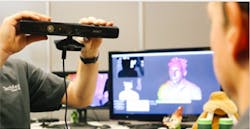Microsoft demos Kinect Fusion
Engineers at Microsoft (Redmond, Washington) demonstrated the capabilities of the Kinect Fusion at the company's annual TechFest event this month in Redmond, Washington.
Kinect Fusion pulls depth data that is generated by the Kinect for Windows sensor and, from the sequence of frames, constructs a 3-D map of objects or environments. The tool averages readings over hundreds or even thousands of frames to create a rich level of detail.
The Kinect Fusion project, shown during TechFest 2013, enables models to be scanned and reconstructed in 3-D models using just a handheld Kinect for Windows sensor.
“Normally, when you think of Kinect, you think of a static sensor in a living room. But with Kinect Fusion, we allow the user to hold the camera, explore their space, and rapidly scan the world around them,” says Shahram Izadi, senior researcher at Microsoft Research Cambridge.
The Cambridge researchers and Kinect for Windows team collaborated closely on Kinect Fusion which will be included it in a future release of the Kinect for Windows SDK.
Related articles from Vision Systems Design that you might also find of interest.
1. Kinect system senses depth in tanks
Researchers from the Universidad Militar Neueva Granada (Bogota, Colombia) have developed a system that uses a Microsoft Kinect sensor coupled with proportional fuzzy logic controllers to detect and control the levels of liquids in tanks.
2. Kinect used to create 3-D death mask of Newton
Researchers at Microsoft Research Laboratory (Cambridge, UK) have used a Kinect camera to produce the first ever 3-D scan of Sir Isaac Newton's death mask.
3. Kinect aids rehabilitation of stroke patients
Researchers at Nottingham Trent University (Nottingham, UK) have been awarded a £347,000 grant to investigate how Microsoft's Kinect can assist with the rehabilitation of individuals with facial paralysis caused by a stroke.
-- Dave Wilson, Senior Editor, Vision Systems Design
